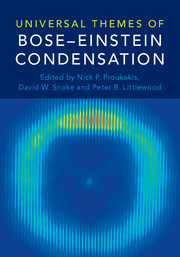Book contents
- Frontmatter
- Contents
- Foreword
- Preface
- Part I Introduction
- Part II General Topics
- Editorial Notes
- 5 The Question of Spontaneous Symmetry Breaking in Condensates
- 6 Effects of Interactions on Bose-Einstein Condensation
- 7 Formation of Bose-Einstein Condensates
- 8 Quenches, Relaxation, and Prethermalization in an Isolated Quantum System
- 9 Ultracold Gases with Intrinsic Scale Invariance
- 10 Berezinskii-Kosterlitz-Thouless Phase of a Driven-Dissipative Condensate
- 11 Superfluidity and Phase Correlations of Driven Dissipative Condensates
- 12 BEC to BCS Crossover from Superconductors to Polaritons
- Part III Condensates in Atomic Physics
- Part IV Condensates in Condensed Matter Physics
- Part V Condensates in Astrophysics and Cosmology
- Universal Bose-Einstein Condensation Workshop
- Contributors
- Index
- References
6 - Effects of Interactions on Bose-Einstein Condensation
from Part II - General Topics
Published online by Cambridge University Press: 18 May 2017
- Frontmatter
- Contents
- Foreword
- Preface
- Part I Introduction
- Part II General Topics
- Editorial Notes
- 5 The Question of Spontaneous Symmetry Breaking in Condensates
- 6 Effects of Interactions on Bose-Einstein Condensation
- 7 Formation of Bose-Einstein Condensates
- 8 Quenches, Relaxation, and Prethermalization in an Isolated Quantum System
- 9 Ultracold Gases with Intrinsic Scale Invariance
- 10 Berezinskii-Kosterlitz-Thouless Phase of a Driven-Dissipative Condensate
- 11 Superfluidity and Phase Correlations of Driven Dissipative Condensates
- 12 BEC to BCS Crossover from Superconductors to Polaritons
- Part III Condensates in Atomic Physics
- Part IV Condensates in Condensed Matter Physics
- Part V Condensates in Astrophysics and Cosmology
- Universal Bose-Einstein Condensation Workshop
- Contributors
- Index
- References
Summary
Bose-Einstein condensation is a unique phase transition in that it is not driven by interparticle interactions, but can theoretically occur in an ideal gas, purely as a consequence of quantum statistics. This chapter addresses the question, ‘How is this ideal Bose gas condensation modified in the presence of interactions between the particles?’ This seemingly simple question turns out to be surprisingly difficult to answer. Here we outline the theoretical background to this question and discuss some recent measurements on ultracold atomic Bose gases that have sought to provide some answers.
Introduction
Unlike the vast majority of phase transitions, Bose-Einstein condensation (BEC) is not driven by interparticle interactions but can theoretically occur in an ideal (noninteracting) gas, purely as a consequence of quantum statistics. However, in reality, interactions are needed for a Bose gas to remain close to thermal equilibrium. It is thus interesting to discuss if something close to ideal gas BEC can be observed in a real system and what happens in the vicinity of the BEC transition in the presence of interparticle interactions. These simple questions have not been easy to answer, either theoretically or experimentally.
The theoretical foundations for studying the effect of interactions on Bose condensed systems were laid over half a century ago by Bogoliubov [1], Penrose and Onsager [2], and Belieav [3], among others. These works initially focused on zerotemperature properties and were extended to nonzero temperature in the pioneering papers of Lee, Huang, and Yang [4, 5, 6, 7]. At that time, the main experimental system was liquid He-4 in which the inter-particle interactions are strong, making connections with theory difficult. The realisation in 1995 of BEC in weakly interacting ultracold atomic gases [8, 9] thus opened up the possibility to experimentally revisit some of these long-discussed questions. This was further aided by, among other advances, the use of Feshbach resonances to tune the interaction strength in atomic gases [10, 11]. Thus, in the last twenty years the study of ultracold Bose gases has been very successful (see Chapter 3 for an insightful account of selected topics and surprising developments over this exciting period). However, the fact that, until recently, ultracold atoms were confined using harmonic potentials has hindered the study of the BEC transition itself.
- Type
- Chapter
- Information
- Universal Themes of Bose-Einstein Condensation , pp. 99 - 116Publisher: Cambridge University PressPrint publication year: 2017

